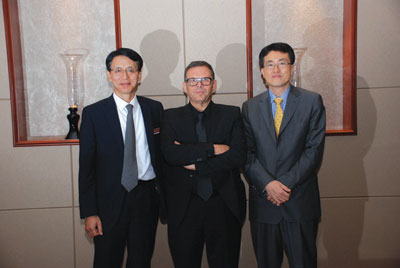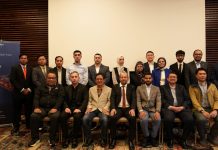A special event was held in Muscat recently to mark the Middle East and Africa preview of the all-new Kia Quoris luxury flagship sedan.
The top management team from Kia Motor Corporation, Seoul, consisting of Jae Yong Chung, director – Middle East and Africa/Asia Pacific operations, Peter Schreyer, Kia’s renowned chief design officer and Soon-Nam Lee, director – overseas marketing group were in Muscat for this exclusive launch event. They took time out from their busy schedule to speak to OER. Excerpts:
Kia is entering a new segment with Quoris. What kind of a design challenge did a car like this present?
Schreyer: When you do a big luxury sedan, it is a big challenge for a designer as one needs to put in a lot of efforts. Having worked for a German company for a long time, I have the advantage of having grown up in that kind of a car culture. This enables me and my team to make cars that have the best in class designs and are on the same level as European manufacturers.
Are there a certain design elements in the Quoris that you would like to highlight?
Schreyer: For me it is not about the details but the overall stance of the car, when you see it on the street and the way it sits. The car exhibits dignity and sportiness and it reflects the kind of car that it is. In all cars that I design, I try to blend the exterior and interior design. The interiors of the Quoris is very good and spacy. When you sit on the back seat, it is luxurious and nice. It is not a typical chauffer driven car but a driver’s car and that’s what I like about it.
The Quoris must have presented the challenge of maintaining the unity of the car with other Kia brands, while differentiating it at the same time. Have you managed to achieve this balance?
Schreyer: Yes we have managed to do this successfully. It is important that the car stands out from the rest of the product range, to show its positioning as a premium luxury sedan, but it also needs to fit into the Kia family. It is the boss of the family but it is also a part of the family and that has been achieved.
You have often remarked that there needs to be a balance between what a designer would like to do creatively and what should be done realistically in line with regulatory and safety standards. Does the pressure of being real go against your design aspirations?
Schreyer: This is our daily work. A car is not just about design alone or engineering, it’s more about how design and engineering strike the best possible compromise. Creating a car is always about making a lot of compromises for the best possible product. One has to find solutions in various details, because at the end of the day all of us want to make a great car.
Kia Motors has been doing exceptionally well in various markets. Given this scenario why was the need felt for a luxury sedan?
Chung: Our 2016 vision for Kia is to become a tier 1 brand and to achieve this we needed a strategic model. If you look at our range we have the Kia Soul, and the Quoris in the premium luxury segment. Our domestic market needed an upmarket premium car and our first objective was to satisfy this demand. Secondly, in the US market we already have the Optima and Cerato and to attract customers we needed to upgrade our offering. Keeping this in mind we introduced the Cadenza first and the next step is the Quoris. That’s the reason why we developed these cars.
Customers of a premium luxury sedan are usually driven by a brand name. Are you concerned that there may be few takers for the Kia Quoris at a higher price point?
Schreyer: The only way to mitigate this perception is by convincing customers about the product. I remember having the same discussion at Audi, 30 years back. Audi had no value at that time and it was not seen as a premium brand at all. So you need to take that first step with a striking new product. You cannot change the badge or brand, but you can come up with a state-of-the-art product and perceptions will start to change.
Companies like Toyota and Nissan have created luxury brands like Lexus and Infinity while entering the premium luxury segment. Why was such a strategy not considered by Kia?
Lee: Looking at the investment and benefits that would accrue from such a strategy we decided against it and planned to keep our current brand name.
Where are you planning to manufacture the Quoris and what kind of numbers do you expect to sell in the first year?
Chung: The Quoris will be manufactured in Korea and we expect to export 3,000 Quoris cars in the first year. This figure excludes the US market as we will start production for the US at the end of 2013. In the Middle East we are looking at selling 1,600 cars in a year or so.
How is Kia Motors performance been in 2012 and have you been impacted by the slowdown in Europe?
Lee: We have seen a 12 per cent growth till July 2012 compared to the seven months of last year and are on course to better our target of 9.5 per cent growth in 2012. Though Western Europe is going through a slowdown, Kia has seen a 23 per cent growth in that market compared to 2011. Similarly, we have seen double digit growth in Middle East and Africa. In China we have grown by over 15 per cent. There has been a huge perception change towards Kia.
How has Kia’s performance been in emerging markets?
Lee: We have been doing very well in South East Asian countries like Indonesia, where we have doubled our volumes, and in Malaysia. Our biggest concern in Asia is that we are not in a position to give our distributors the number of cars that they demand from us.
Your new design for Kia with the Tiger nose grill has been a great success. How are you going to improve upon it?
Schreyer: We are a very young brand and we are at the beginning of our journey into the future. This is the first time that we have been able to create a family feel for the entire product range. You can see a homogenous, coherent product range from the Picanto upto the Quoris. We have to continue to be proud and confident about what we have achieved.
We are still in a learning phase in a positive manner. We have introduced our front grill and our face, but this is something that we have had only for 4-5 years compared to others who have had a design identity for 100 years. Of course we will surprise our customers but we are building a brand and it takes a long time. A brand needs to give customers a feel of reliability and assurance that the next car is better than their previous car.
What was the inspiration for the signature Tiger nose grills that Kia cars flaunt?
Schreyer: Though we called it the Tiger nose later on, the tiger was not the inspiration, we were working on a show car in 2007. I was new and was desperately thinking about making a grill that would give a good impression, hold value for the future and be something that could be used for generations of cars.
The grill is a very strong identifier, even when you see it from a distance or even without the badge and it just came up during work. It was only later that I used the Tiger metaphor to give our designers a sense of how a three dimensional front should be.






